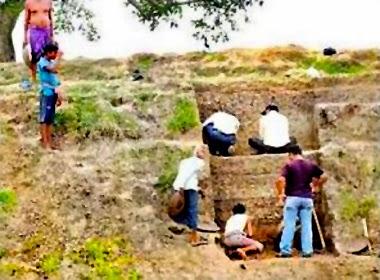Minati Singha
Source - http://timesofindia.indiatimes.com/
The Archaeological Survey of India (ASI) has started extensive excavation at Suabarai village in Pipili block about 15 km from here after indications emerged in June last year of the presence of a civilization that flourished nearly 3,500 years ago during the Chalcolithic Age.

Ancient site at Suabarai under ASI excavation [Credit: Odisha Sun Times]
"We can't say anything until we find some concrete evidence about the existence of an ancient civilization here," said deputy director of ASI Jeevan Patnaik. The excavation began on a mound amidst paddy fields located on the banks of the Daya river and at the southern end of the historic Dhauli Hills. This is the same place where the famous Kalinga War was fought in 261 BC. Some 1,50,000 fought in the war and about 1,00,000 were slain, according to a rock edict from the period found on the hills. During excavation in June 2014, the ASI team had found some remnants of earthen pots, fragments of pots made of red soil, and ancient stones that pointed to the existence of a human civilization. Also the excavators found deer horns, two animal teeth measuring two inches each and skeletal remains of birds and animals at the site. "ASI decided to start excavation on the site after villagers unearthed two four-feet tall ancient stone sculptures from the mound while digging a pit in April 2013," an official source said. The excavation has been undertaken by a technical team consisting of archaeologists Sanjay Panda and Suvendu Kumar Khuntia. The digging will continue till the onset of the rainy season, sources said. "It is possible that human skeletons may be found at the site. So, digging work is being done very carefully," said an officer. Anthropologists from Utkal University in Bhubaneswar had unearthed two human skeletons at Banga in Harirajpur area under Delanga block in Puri district, about 25 km from the city in 2013.The remnants were said to be around 3,500 to 4,000 years old and from the Chalcolithic Age. The excavation also has significance as it may throw light on the development and growth of the ancient civilization at Sishupalgarh on the outskirts of the city. Sishupalgarh was an urban centre with a population of more than 20,000 that flourished between 500 BC and 600 AD.